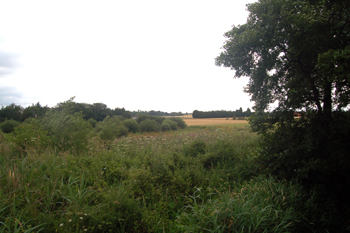Beadlow Priory

The site of Beadlow Priory, July 2010
Beadlow Priory is also known as Beaulieu Priory or the Priory de Bello Loco - French and Latin respectively for "beautiful place". It was a house of the Benedictine monks, the order having been founded in the 6th century at Subiaco, in Italy, by Saint Benedict of Nursia (480-547). Volume I of the Victoria County History for Bedfordshire, published in 1904 states that the priory was founded at a date between 1140 and 1146 on the site of a hermitage at a place then called Moddry (considered by philologists to be a spurious name and the result of a misreading) and was granted to Saint Albans Abbey as a cell of that monastery. The new priory was granted a cell of its own at Millbrook which had been founded at some time between 1097 and 1119.
The original endowment provided for four or five monks and it is supposed that this number never increased significantly. The priory had the advowson of the church at Milton Ernest and was involved in a protracted legal dispute when the son of the founder wished to take the advowson back for himself but the grant to Beadlow was confirmed in 1275. A fire occurred in the 14th century partially destroying the house.
The Abbot of Saint Albans, John of Wheathampstead, visited Beadlow in the early 15th century and found it in such a poor condition that it barely supported two monks. He decided to close the house and unite it with Saint Albans. The patron of the house, Lord Grey of Ruthyn agreed to this in 1434 and the Papal Bull, the last necessary step, was received about the same time but a royal official named the Escheator stepped in and declared that the priory was forfeit to the Crown. A jury was summoned to investigate the Abbot of Saint Albans's title to Beadlow which, if it could not be proved, would have seen the priory remain with the Crown. Given that the Abbot was able to close the house successfully and apply its income, such as it was, to other uses, his title must have been proved.
The names of the Priors of Beadlow that are known are:
- Walter de Standon - elected 1233;
- Roger - elected 1237;
- Roger de Thebrugg - elected 1281;
- John of Stopsley - elected 1285;
- John of Stagsden - transferred 1296;
- William de Parys - elected 1296;
- Peter de Maydenford - elected 1299;
- Gregory of Saint Albans - elected 1302;
- Richard of Northampton - elected 1305;
- William of Kirkby - elected 1310, transferred 1312;
- Richard of Hertford - elected 1312;
- Henry of Saint Neots - elected 1316;
- Adam of Newark - elected 1340;
- John of Caldwell - elected 1351;
- William of Winslow - elected 1374;
- John Warham - at least 1396 until at least 1401;
- Richard Smyth of Missenden - at least 1405 to 1428
Mary Phillips wrote two articles on the priory for The Bedfordshire Magazine in 1962 and noted that if the priory followed the conventional pattern the kitchen and refectory [dining room] would have been on the stream, the porch or outer court to the west and the chapel and chapter house (where the monks met to discuss official business) to the north-east with a cloister in the centre of the buildings. Mary Phillips in her first article (Volume 8 Number 62 pages 244-246) relates the land granted to Beadlow at its foundation as its endowment and identifies some of the locations. She relates that at the end of the 13th century the monks held a feast on 22nd July at which a hundred poor people were fed at the cost of a penny a head and at which prayers were offered for Queen Eleanor, late wife of King Edward I (1272-1307) who had died in 1290. On the third anniversary of her death, 28th November 1293 the prior was granted the right to hold a fair from 24th to 26th July each year.
In the second part of her history, published in Volume 8, number 63 pages 281-284, Mary Phillips noted that the fire at Beadlow occurred in 1394. Margaret, Countess of Norfolk, gave money towards the restoration and a Wales laws built to enclose most of the priory. She states that the monks finally left Beadlow in 1428, leaving just a chaplain behind to take services and thus fulfil the condition of the priory's foundation.
Volume III of Bedfordshire Archaeological Journal (1966, pages 31-34) carries a report by Kevan Fadden of excavations of the priory in the field immediately east of Top Farm. The dig was inspired by Mary Phillips' articles in The Bedfordshire Magazine. He noted: "The task of locating the site was not difficult, as the farmer, Mr. R. Gobey, had just ploughed a field for the first time from pasture, turning up considerable amounts of medieval roof tiles and mortar".
The excavation unearthed the following materials:
- Animal bones including horse, ox, dog, sheep, deer, pig and rabbit;
- Oyster shells;
- Fragments of glass including stained glass window fragments;
- A groat of the first year of Queen Mary I - 1553-1554.;
- Pumice stone, a whet stone and a mill quern;
- A small number of decorated floor tiles;
- Fragments of pottery.
The Historic Environment Record [HER] details all historic buildings and landscape features in the county and is now accessible on-line as part of the Heritage Gateway site. The entry for Beadlow Priory [HER 813] notes that the priory was adopted to become the Manor of Beadlow and that the priory chapel survived into the 17th century. Bedfordshire and Luton Archives and Records Service has a lease of the Manor of Beadlow of 1538 [ref: X4/1] in which the lessee was to keep "the leaded chapel" in repair.